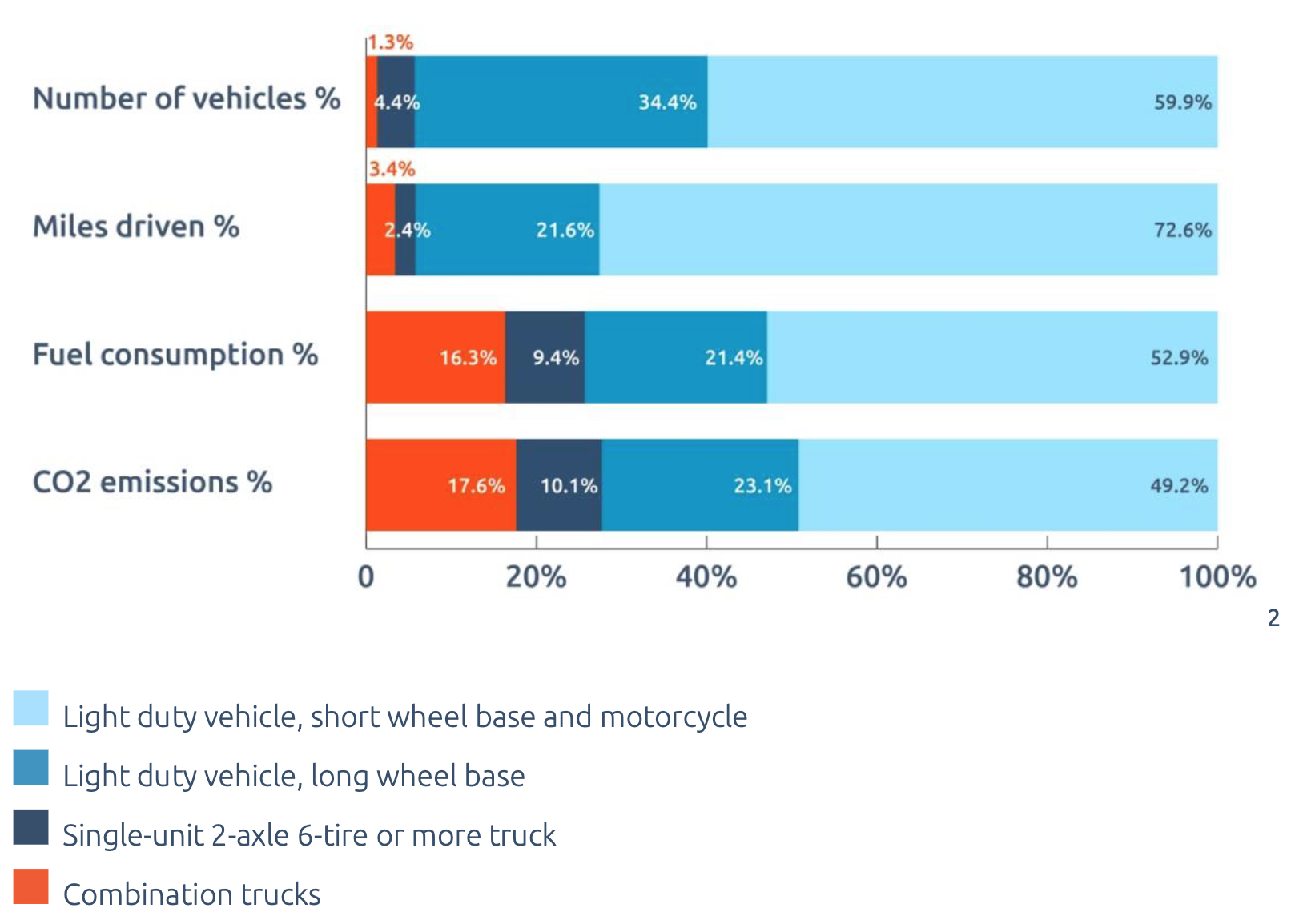A new report shows that commercial vehicles are much higher polluters than passenger vehicles despite making up a much smaller portion of cars on U.S. roads. For this reason, the study’s authors say the U.S. should prioritize electrifying the commercial vehicles sector rather than just focusing on passenger vehicles.
PepsiCo- and KPMG-backed software logistics company Adiona Tech shared the Connected Thinking report on Tuesday, which suggests that last-mile combination trucks be electrified as soon as possible to help fight CO2 emissions. The company says that all urban deliveries of groceries, parcels, furniture and other goods should be performed by electric vehicles (EVs) by 2025.
“Commercial vehicles are a much bigger polluter than passenger cars and they are in desperate need of modernization,” Adiona writes in the report. “Large combination trucks are just 1 percent of vehicles on the road, but they produce 18 percent of vehicle emissions.”
The study compared Bureau of Transportation Statistics figures from 2019 to those of 2020 and 2021, looking at vehicle miles driven by passenger cars and trucks, along with their associated emissions. What it found was that emissions decreased significantly in 2020 and 2021, while truck miles and their associated emissions increased above 18 percent of road traffic emissions.

Sources: Connected Fleet data; BTS, fuel consumption by mode, additional combination truck stats, additional car stats, additional single-axle truck stats. Credit: Adiona Tech
The report included several key findings, notably including that the average fuel consumption of combination trucks is roughly 20 times higher than that of a passenger vehicle. The report also says that switching just five of these combination trucks to green alternatives — such as hydrogen fuel cells or lithium batteries — would be comparable to the effects of buying EVs for 100 households.
While the average truck drives about 22,930 miles annually, the report notes that large combination trucks travel an average of 59,929 miles in the same period, and single-unit trucks only average 12,278 miles annually.
According to data sourced from the Bureau of Transportation, light-duty vehicles with a short wheelbase have an average fuel consumption of 481 gallons per year, compared to 640 gallons consumed on average by light-duty vehicles with long wheelbases, and 1,639 gallons on average by single-unit, two-axle trucks with six tires or more. However, the data also shows that combination trucks consume an average of 9,909 gallons annually.
In a press release, Adiona Tech CEO Richard Savoie highlights the need to prioritize larger freight in the fight against carbon emissions, beginning with those that travel the most.
“America needs to aggressively decarbonize the biggest emitters on the road, large freight and delivery vehicles,” Savoie said in the release. “The US automotive industry is at a crossroads, but it needs to act now to electrify every car on the road. Doing so requires connected thinking and collective action. We cannot transform the national fleet of nearly 300 million vehicles overnight, so we need to make decisions that make the biggest difference, for the lowest effort first.”
The passenger vehicle sector has adopted EVs much more quickly than others, as several automakers have now followed Tesla’s lead in building fully electric vehicles. While electrifying every car is still an important goal, Savoie explains, it shouldn’t be the only one.
“Frankly, the data shows that consumer adoption of EVs should not be America’s number one priority,” Savoie said. “Electrifying fleets is by far the most efficient way to reduce vehicle emissions. Every battery we put in a combination truck counts for 20 households buying an EV, and businesses often have fleets of hundreds of vehicles.”
“We must prioritize the electrification of these vehicles that are on the road most, travel the longest distances, and are the least fuel-efficient,” Savoie added.
Several companies have begun piloting or at least stated plans to purchase electric last-mile delivery vehicles, including FedEx, Amazon, Walmart and more.
Adiona Tech backer PepsiCo is one of the first companies to have begun electrifying its semi-truck fleet after purchasing an initial batch of Tesla Semis last year. A recent event showed some serious range results for the Semi, and PepsiCo detailed last month how the truck was helping it reach its own sustainability goals.
You can read the full report from Adiona Tech here.
What are your thoughts? Let me know at zach@teslarati.com, find me on X at @zacharyvisconti, or send your tips to us at tips@teslarati.com.

News
Tesla aims to combat common Full Self-Driving problem with new patent
Tesla writes in the patent that its autonomous and semi-autonomous vehicles are heavily reliant on camera systems to navigate and interact with their environment.

Tesla is aiming to combat a common Full Self-Driving problem with a new patent.
One issue with Tesla’s vision-based approach is that sunlight glare can become a troublesome element of everyday travel. Full Self-Driving is certainly an amazing technology, but there are still things Tesla is aiming to figure out with its development.
Unfortunately, it is extremely difficult to get around this issue, and even humans need ways to combat it when they’re driving, as we commonly use sunglasses or sun visors to give us better visibility.
Cameras obviously do not have these ways to fight sunglare, but a new patent Tesla recently had published aims to fight this through a “glare shield.”
Tesla writes in the patent that its autonomous and semi-autonomous vehicles are heavily reliant on camera systems to navigate and interact with their environment.

The ability to see surroundings is crucial for accurate performance, and glare is one element of interference that has yet to be confronted.
Tesla described the patent, which will utilize “a textured surface composed of an array of micro-cones, or cone-shaped formations, which serve to scatter incident light in various directions, thereby reducing glare and improving camera vision.”

The patent was first spotted by Not a Tesla App.
The design of the micro-cones is the first element of the puzzle to fight the excess glare. The patent says they are “optimized in size, angle, and orientation to minimize Total Hemispherical Reflectance (THR) and reflection penalty, enhancing the camera’s ability to accurately interpret visual data.”
Additionally, there is an electromechanical system for dynamic orientation adjustment, which will allow the micro-cones to move based on the angle of external light sources.
This is not the only thing Tesla is mulling to resolve issues with sunlight glare, as it has also worked on two other ways to combat the problem. One thing the company has discussed is a direct photon count.
CEO Elon Musk said during the Q2 Earnings Call:
“We use an approach which is direct photon count. When you see a processed image, so the image that goes from the sort of photon counter — the silicon photon counter — that then goes through a digital signal processor or image signal processor, that’s normally what happens. And then the image that you see looks all washed out, because if you point the camera at the sun, the post-processing of the photon counting washes things out.”
Future Hardware iterations, like Hardware 5 and Hardware 6, could also integrate better solutions for the sunglare issue, such as neutral density filters or heated lenses, aiming to solve glare more effectively.
Elon Musk
Delaware Supreme Court reinstates Elon Musk’s 2018 Tesla CEO pay package
The unanimous decision criticized the prior total rescission as “improper and inequitable,” arguing that it left Musk uncompensated for six years of transformative leadership at Tesla.

The Delaware Supreme Court has overturned a lower court ruling, reinstating Elon Musk’s 2018 compensation package originally valued at $56 billion but now worth approximately $139 billion due to Tesla’s soaring stock price.
The unanimous decision criticized the prior total rescission as “improper and inequitable,” arguing that it left Musk uncompensated for six years of transformative leadership at Tesla. Musk quickly celebrated the outcome on X, stating that he felt “vindicated.” He also shared his gratitude to TSLA shareholders.
Delaware Supreme Court makes a decision
In a 49-page ruling Friday, the Delaware Supreme Court reversed Chancellor Kathaleen McCormick’s 2024 decision that voided the 2018 package over alleged board conflicts and inadequate shareholder disclosures. The high court acknowledged varying views on liability but agreed rescission was excessive, stating it “leaves Musk uncompensated for his time and efforts over a period of six years.”
The 2018 plan granted Musk options on about 304 million shares upon hitting aggressive milestones, all of which were achieved ahead of time. Shareholders overwhelmingly approved it initially in 2018 and ratified it once again in 2024 after the Delaware lower court struck it down. The case against Musk’s 2018 pay package was filed by plaintiff Richard Tornetta, who held just nine shares when the compensation plan was approved.
A hard-fought victory
As noted in a Reuters report, Tesla’s win avoids a potential $26 billion earnings hit from replacing the award at current prices. Tesla, now Texas-incorporated, had hedged with interim plans, including a November 2025 shareholder-approved package potentially worth $878 billion tied to Robotaxi and Optimus goals and other extremely aggressive operational milestones.
The saga surrounding Elon Musk’s 2018 pay package ultimately damaged Delaware’s corporate appeal, prompting a number of high-profile firms, such as Dropbox, Roblox, Trade Desk, and Coinbase, to follow Tesla’s exodus out of the state. What added more fuel to the issue was the fact that Tornetta’s legal team, following the lower court’s 2024 decision, demanded a fee request of more than $5.1 billion worth of TSLA stock, which was equal to an hourly rate of over $200,000.
Delaware Supreme Court Elon Musk 2018 Pay Package by Simon Alvarez
News
Tesla Cybercab tests are going on overdrive with production-ready units
Tesla is ramping its real-world tests of the Cybercab, with multiple sightings of the vehicle being reported across social media this week.

Tesla is ramping its real-world tests of the Cybercab, with multiple sightings of the autonomous two-seater being reported across social media this week. Based on videos of the vehicle that have been shared online, it appears that Cybercab tests are underway across multiple states.
Recent Cybercab sightings
Reports of Cybercab tests have ramped this week, with a vehicle that looked like a production-ready prototype being spotted at Apple’s Visitor Center in California. The vehicle in this sighting was interesting as it was equipped with a steering wheel. The vehicle also featured some changes to the design of its brake lights.
The Cybercab was also filmed testing at the Fremont factory’s test track, which also seemed to involve a vehicle that looked production-ready. This also seemed to be the case for a Cybercab that was spotted in Austin, Texas, which happened to be undergoing real-world tests. Overall, these sightings suggest that Cybercab testing is fully underway, and the vehicle is really moving towards production.
Production design all but finalized?
Recently, a near-production-ready Cybercab was showcased at Tesla’s Santana Row showroom in San Jose. The vehicle was equipped with frameless windows, dual windshield wipers, powered butterfly door struts, an extended front splitter, an updated lightbar, new wheel covers, and a license plate bracket. Interior updates include redesigned dash/door panels, refined seats with center cupholders, updated carpet, and what appeared to be improved legroom.
There seems to be a pretty good chance that the Cybercab’s design has been all but finalized, at least considering Elon Musk’s comments at the 2025 Annual Shareholder Meeting. During the event, Musk confirmed that the vehicle will enter production around April 2026, and its production targets will be quite ambitious.










